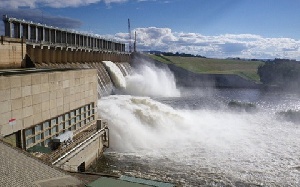Ebenezer Teye Nartey, the Ada-East Director of the National Disaster Management Organisation (NADMO), says a total of 5,685 people and 1,135 households from 28 communities in the district were affected during the Akosombo Dam spillage last year.
Speaking during a stakeholders’ engagement held by the Volta River Authority (VRA) at the Ada East District Assembly on the precautionary spilling of the dam this year, he stated that while 776 of the affected persons resided in the safe havens provided, 4,909 decided to remain in the flooded communities.
He said 283 farms, seven fishermen, livestock farmers, and oyster miners were also affected, and eight schools, including five on the island and three on the land, one Community Health Planning and Services (CHPS) compound, and one clinic, both on the island, were also affected.
He explained that businesses were also indirectly impacted as fishing activities halted, with other food vendors who depend on fish and other farm produce for their activities putting their businesses on hold.
He said over 120 flood victims were evacuated from communities including Alorwusedekope, Aflive, Kewuse, Kweunor, and Azizakpe on the first day and sent to safe havens, adding that other safe havens were later added at Azizanya and Methodist Basic School, while the Volta River Foundation and non-governmental organisations also helped in diverse ways.
He said 63 donors, comprising companies, churches, individuals, the Ada Traditional Council, VRA, and others, contributed to the disaster relief activities, and the victims spent nine weeks at the camp from October 15 to December 19, 2023.
He said the victims, during their stay at the safe havens, received guidance and counselling, medical supplies, and prayers, while there was also the presence of security and administrative staff to coordinate activities in the camp.
Mr. Nartey added that cash donations received from the Anglican Church, Tema, and the World Food Programme, in collaboration with international and national parties, were distributed among victims, ranging between GHS 700 and GHS 1,800 each, depending on the severity of their conditions.
He said that out of GHS 95,000.00 spent on the victims, only GHS 15,000 of the expenditure had been paid, with arrears of GHS 80,000 yet to be cleared.
He recommended that the flood victims should be supported with start-up capital, settlement centres for the vulnerable, and the provision of potable water for the affected communities, as they were currently facing severe economic hardship.
He called for intensified community and media engagements to create awareness and prepare the community members before any spillage so they would be aware of the expected impact of the spillage on them.
Click to view details



General News of Tuesday, 23 July 2024
Source: GNA
About 5,685 people were affected by Akosombo dam spillage in Ada – NADMO
Opinions
















